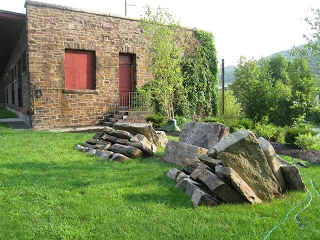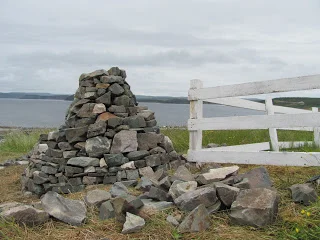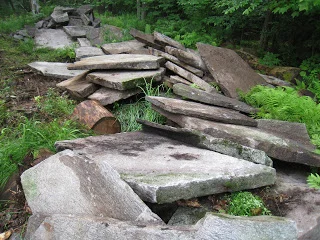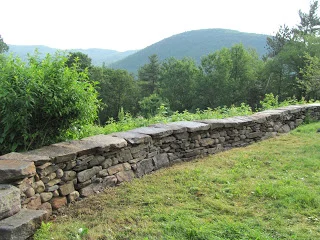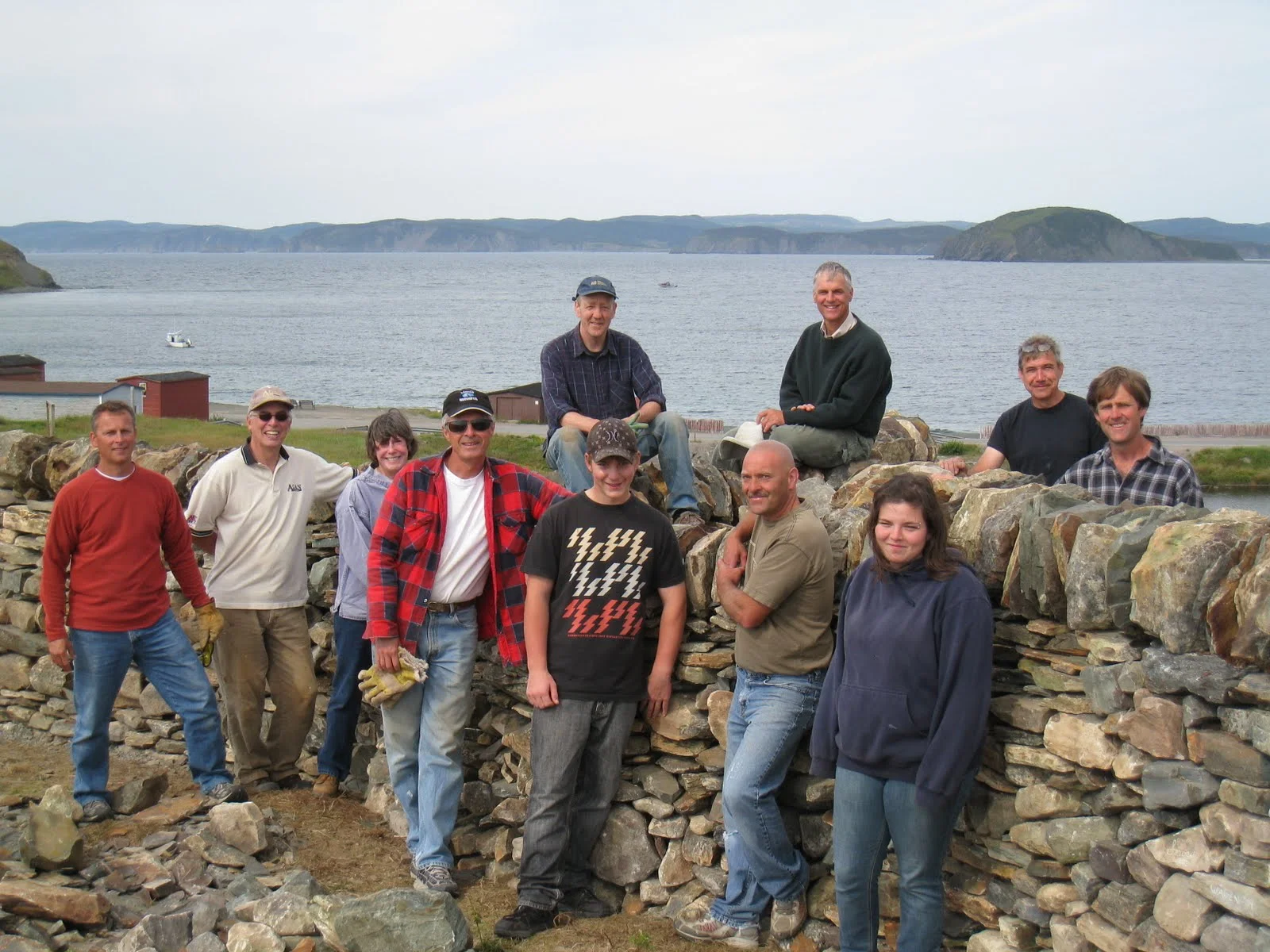During my working life I’ve shifted freely, back and forth, from artist to dry stone waller. Whatever the final outcome of any work, it’s been the making that I’ve liked the best. With ‘Rock Rest’, I enjoyed the creative process so much that I built the piece twice; once in my Dummerston stone yard and once here beside the museum. The stone was initially collected from a steep slope on a wooded property in Townshend. It lay there for twelve thousand years after being plucked from the ledges by the last ice age. In ‘Rock Rest’ I’ve attempted to simulate the natural process that turns bedrock into loose stone. I’ve always been fascinated by the way stones separate from one another but lock more tightly together as they slide apart.
Read MoreThe dry stone workshops at English Harbour have been treated to buffeting winds, lightning storms, muffling fog and dazzling sunshine over these past two weeks. Participants have gone from working in tee shirts to suiting up in insulated rain-gear. Whatever the weather conditions of the day (or hour) it’s been exhilarating working on the Newfoundland coast. The wide vistas of boreal forestland and ever-changing seascape have made a dramatic backdrop to our dry stone activities.
Read MoreWhile other parts of Canada are experiencing record high temperatures, here on the east coast of Newfoundland we go about in wool sweaters and windbreakers. Lightning storms have made quick visits overhead in the nighttime. Strong winds blow intermittently through the day. But always, in the past week, there has been fog. Time stands still when the quality of light remains the same from dawn to dusk. It’s the color of pewter tinged with green from the landscape of meadow grass and spruce forest. And always the mournful moan of the foghorn in the background calling out from the coastal headlands; a sound I don’t so much hear, as feel in my body like the rise and fall of a breath.
Read MoreHaving the fresh supply of stone at my disposal, from last week’s harvesting, has been like getting a blood transfusion for the imagination. I can design with select pieces in mind. I knew when I saw the 6’x7’ slab in the jumble of stone that came off the hillside in Townshend that it was destined for this project in Dummerston.
Read MoreLast week’s stone gathering was harsh work in a tranquil setting. The side-hill that I harvest loose stone from is a mile into the woods up a steep trail. Until the Clark’s and I invaded the scene with loading and transport equipment it was peaceful wilderness. A working landscape, by definition, must tolerate periodic disruptions. The stone I collect from the property will keep me supplied in dry stone construction materials for two years, building things like the barbecue table I made for my friends Peter and Phyllis. Saturday evening’s cookout at their place was as delicious as the sky was dramatic.
Read MoreThanks to Sunny Wieler from Ireland for the mention of Sky Watch on his recent stargazing in the garden article - and for telling me about these beautifully hand crafted garden telescopes - also from Vermont.
Read MoreThe road to a project’s completion is often a long and winding one. That’s why it’s worth taking time along the way to enjoy the view. The installation I’ll be doing at TICKON in Denmark later this summer began last year with an invitation from the art park to submit a proposal. Over the months, conversations and emails have taken the proposal through a series of development where I now feel that all the parts are in place to begin the work.
Read MoreSometimes a single stone is just too big to lift with available equipment. A simple solution is to turn it into two. A rotary hammer armed with a masonry bit will drill six, ⅝” holes in less than ten minutes. Wedge and shim sets are tapped into the holes until a seam opens and the stone pops apart.
Read MoreMy interview on Vermont Public Radio is airing at noon today - most likely after the segment on under-age drinking parties.
Jane Lindholm visited me at work in Dummerston last week for a feature on this month's installment in Vermont Edition's "Visiting Artists" series. Click on VPR's Vermont Edition for more info.
Read MoreThis week I put in a couple days on a “subscription” wall. Every year the customer asks me to add another six yards to its length. They budget a set amount per year for stone work and I schedule it as I wish. This is the third year for this 2’x2’ construction. It follows the circuitous lawn edge at the brink of an embankment. The top line of the wall follows the undulant topography of the lawn. The longer it grows the wigglier it gets.
Read MoreThe Stone Trust wraps up its spring season of dry stone walling activities with an open house this Sunday from 1-4 at Scott Farm. It’s been a productive first year for the organization, with a successful slate of volunteer days, workshops, DSWA tests, pre-test trainings and a two-day Instructor’s course. Anyone and everyone with an interest in preserving and advancing the art and craft of dry stone walling is invited to attend. There will be lemonade, cookies and casual conversation. Please stop by the 1862 barn to say hi, meet members of the board of directors and see what a first-class, four-season, training and testing centre looks like.
Read MoreCultivated land is a handmade environment. In centuries past, the face of Newfoundland was shaped by domestic agricultural activity. While many of the stone walls built during those times have lost their stature as fences, their presence remains a defining characteristic of the land. The close attention that farmers paid to their surroundings is comparable to the awareness artists bring to their work. Dry stone construction is a logical medium of expression for an artist working in the landscape.
Read MoreWorkshop scope: Learn basic dry stone walling skills under the direction of two DSWA Mastercraftsmen. Dave Goulder, from Scotland, and Dummerston resident Dan Snow. They will instruct this one day workshop in the rebuilding of an old stone fence. Building a gate-end and set of steps will also be included.
Read MoreThe trees in the parks of Helsinki were beginning to show signs of awakening from their winter sleep when I arrived here early May. Today, my last day in Finland on this trip, they are flush with lush green leaves. I leave behind good friends, old and new. It’s been an exciting few weeks of city life. The Kerava Art Museum exhibition is now open to the public until August 28 when the artist’s pieces will be dismantled and moved, or recycled. I’m pleased with the way my two works came out. ‘L.E.M.’ is the small stone and steel construction displayed inside the museum in partnership with Tristan Hamel’s silk-paper globe. Outside, ‘Wishing Wells’ invites museum-goers and passer-by’s to walk through and around its canyons and cavities.
Read MoreBelow is the gist of my presentation for the artist’s seminar that preceded the opening of the show at Kerava Art Museum yesterday. The title and theme for this exhibition is ‘Hole in the Universe’. I don’t know how it sounds in Finnish but the word ‘hole’, in English, can be heard as ‘whole’; with a ‘w’. So the title, when spoken, can be interpreted in two ways. Both are interesting concepts to ponder, and respond to by making art. A hole can be a void, a container or a passage way. To become whole in the universe, complete in mind, body and soul, is perhaps the ultimate artists’ quest.
Read MoreThe techniques used to set stones in relation to one another can be varied. The sizes and shapes of the stones in any supply are often the final determining factor in the design of a dry stone structure. The supply limits the possibilities, focusing the process of design on what is doable. Limits actually increase the potential for a successful outcome. By first assessing the qualities of the available stone, a more ornamental or contemporary design might be considered and pursued.
Read MoreThe techniques used to set stones in relation to one another can be varied. The sizes and shapes of the stones in any supply are often the final determining factor in the design of a dry stone structure. The supply limits the possibilities, focusing the process of design on what is doable. Limits actually increase the potential for a successful outcome. By first assessing the qualities of the available stone, a more ornamental or contemporary design might be considered and pursued.
Read MoreThe dry stone sculpture rising out of the lawn outside Kerava Art Museum is beginning to attract local attention. People on their way to work are slowing down as they pass. Some stop and ask what’s happening. I learned through a student interpreter that one fellow said he liked seeing natural stone being used, that every one has a unique and beautiful shape. The people of Finland are surrounded by rock. Even in central Helsinki, bedrock outcrops are everywhere. Stone is only surpassed by forest and water in defining the nature of the landscape, and the psyche of the Finns.
Read More